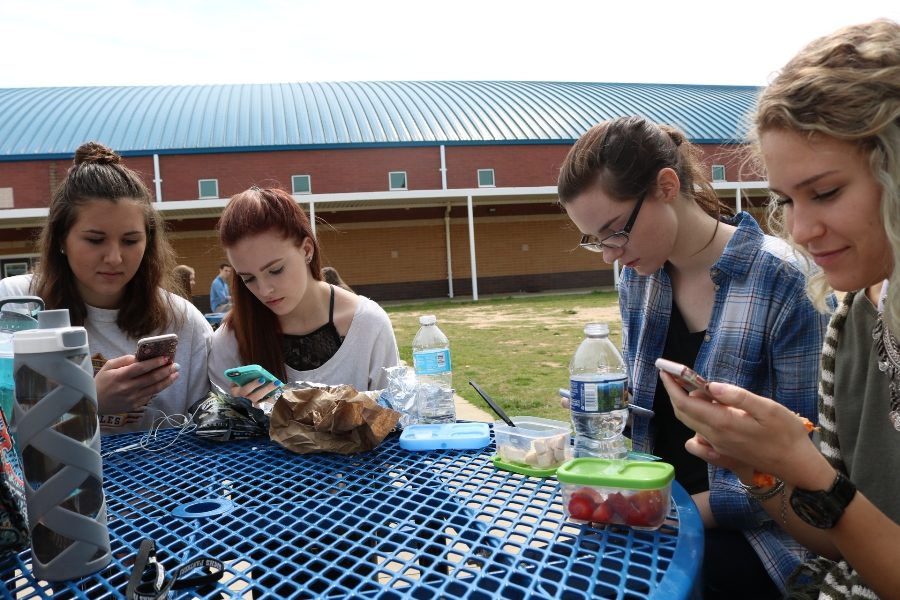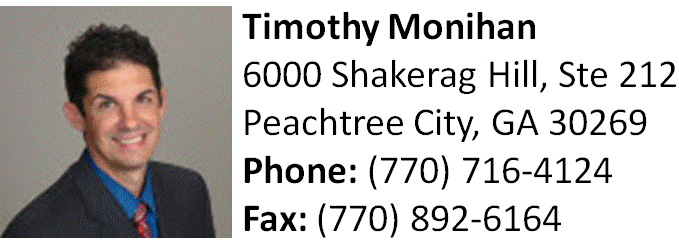Swiping away your time?
The social media phenomenon and its effects on student life
Students sit on the Starr’s Mill patio during C lunch. Although they sit together, this friend group and many others at Starr’s Mill pay no attention to each other or make conversation. Instead, each person is ensnared by their social media feeds. “Social media takes up time that is not easily made up. It takes away from school and friendships in some cases,” sophomore Blake Ryan said.
April 10, 2017
When senior Noah McPherson checks in for work at a local pizza joint to wait tables, he can’t help but notice the number of people engaged on their smartphones instead of engaged in conversation with the people their sitting with. “When a bunch of teenagers walk in, I usually see them on their phones right after I finish taking their order,” McPherson said.
This is a common sight among many teens. “In the cafeteria at lunch, most students sit with their headphones in while looking at their phones and not paying any attention to the people around them,” freshman Anna Samson said.
In addition to places of dining, student social media addicts can be found in abundance in almost every classroom at Starr’s Mill. Students sit hunched over in their seats before and after class, completely engaged in the latest meme or Snapchat story that has run viral through their feed. Samson spends “around three to four hours on [her] phone per day on apps like Instagram, Snapchat, and Twitter,” Samson said. “Seeing what other people are doing in their lives is very entertaining.”
Samson said she believes the reason why social media is so popular is because of “the satisfaction you get when you gossip about someone or get juicy information is the same type of satisfaction you get when you catch a glimpse of other people’s lives [through the use of social media]. It’s the same way around. [Social media provides] an easy outlet to brag about yourself,” Samson said.
Whether it’s to brag about their lives or not, there is no doubt that teens are placing their lives on display for anyone to see. When teens scroll through social media, especially on the Instagram app, which is strictly picture-based, they oftentimes judge the person in the photo and analyze every detail that they see. This hawk-like audience makes McPherson “more self aware,” McPherson said. “Putting everything out there for people to see makes me a lot more self-aware of what I choose to advertise, what I choose to wear, and what I choose to post about. In a way, it makes me more self-conscious.”
McPherson and Samson have both reflected on social social media use and both recognize the harmful effects social media can have on a person. “I often spend hours on my phone and end up regretting my time wasted [on social media] when I could be doing homework, hanging out with my friends, or doing my chores,” Samson said.
Samson wishes she “could put [her] phone down for as long as possible,” Samson said. “Without my phone and social media, I could become so much more productive than I already am and be able to experience life through my own eyes and not a screen.”
Another student, senior Amira Castilla, also enjoys using Instagram, Twitter, Snapchat, and Facebook because, similar to Samson, they allow her to “learn about all types of people and connect to people with similar interests,” Castilla said. Students swipe through their social media feed most often when “there is extra time in class or if there is any type of blank and awkward time,” Castilla said. Sometimes, Castilla herself participates in this method of passing time too. “Sometimes I am that person that gets right on my phone,” Castilla said, “but other times I try to start a conversation and be face to face with someone.”
Changes in the way people converse with one other as a result of social media are evident in everyday life and McPherson believes that social media has hindered in-person interactions. “Nowadays, teens go on their phones as a force of habit. They constantly check whatever app they’re using,” McPherson said.
This seemingly excessive habit has repercussions, at least according to Samson. “Because of the lack of tone, inflection, body language, and etc., in screen-to-screen conversations, our generation is slowly losing touch with one another,” Samson said.
Castilla efforts to not lose touch with her peers can be partly due to her parent’s influence, as they “never wanted [her] to stop using social media, but always wanted [her] to be careful with spending too much of [her] time and energy on it,” Castilla said.
McPherson can relate to the parent monitoring of his social media use. “My mom is always getting onto me about using my phone too much. Everyone in my family mocks me for how often I Snapchat,” McPherson said.
Just like Samson and Castilla, McPherson acknowledges that he uses social media a little more than he should. “I know I’m wasting a lot of time. This year especially I’ve found myself procrastinating more than usual and it’s extremely frustrating because I just can’t focus,” McPherson said.
The time loss due to procrastination creates a chain reaction, where procrastination decreases students’ time to complete assignments provoking large amounts of stress and anxiety. “[Because of constant phone usage], today’s teens generally have higher anxiety levels and feel more stressed in comparison to generations before us,” Samson said.
McPherson is “used to handling high volumes of stress,” McPherson said. “I like to think that I always get everything done. Regardless of how much I procrastinate, it will be done. However, it might not be to the best of my ability.”
Increased procrastination and depleted attention spans have been an experience of many students at the Mill, including sophomore Blake Ryan, who uses Snapchat and Instagram frequently. “I see a lot of people check their social media when they are studying or hanging out in groups. It feels like they are letting social media distract them,” Ryan said. “People have started to get shorter attention spans because they move back and forth between medias so rapidly.”
Though some students do identify or detect a decreased attention span, either in themselves or in their peers, McPherson remains hopeful for the future social-media dependent world. “In the future people will be more connected than ever, which can have benefits. It will allow for people to stay in touch with loved ones no matter where they are,” McPherson said. “People who you don’t necessarily see everyday, you can still text or message them to say “hey, how are you?’ even if they live somewhere far, like Ohio.”
Samson, Castilla, and Ryan have also predicted what the future will look like. As social media use continues to grow, it will “increase the negative impacts on social interactions, making face-to-face conversation decrease and slowly deteriorate,” Samson said.
Castilla has a more positive outlook. “I think that social media will advance, but hopefully we’ll catch ourselves before getting too caught up,” Castilla said.
All three remain sure that the age of social media and its seemingly harmful effects show no signs of slowing down. “It’s just so enticing,” McPherson said. “I know I need to cut back but it is a lot easier said than done.”








